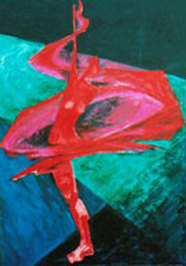PhD Thesis: The Ecological Body ~ extracts
Amerta MovementAmerta Movement
I trained with Suprapto Suryodarmo from 1988-1998. Amerta Movement is the movement practice of Suprapto Suryodarmo, a Javanese movement artist who decided to practise perceiving the world through movement rather than from stasis, or, as he initially described it to us, ‘from the Buddha walking, rather than from the Buddha sitting ’. Alongside Buddhist practice, the development of Amerta Movement was influenced by the practice of Sumarah, a traditional Javanese meditation practice of ‘letting go’ or surrender. Suprapto developed his approach to movement as a life-practice in dialogue with both of these traditions. Amerta is a Javanese word which he translates as the 'nectar' or 'elixir' of life. This practice is based on the basic movements of daily life: walking, sitting, standing, crawling and lying down and the transitions between them, beginning with the observation of children playing. It is also based on moving in nature and an embodied study of movement from the play of elements in motion and the laws of nature. Both as a psychophysical practice and as a cultural attitude, equal attention is given to the environment as to the body-in-movement. The changing environment and being-in-movement are manifestly interdependent in Suprapto’s view and students are guided to develop an awareness of how the changing moment is constantly re-creating itself and the influence of one’s position/transition in that flux. Subsequently, I distilled how my studies could be translated into a way of teaching movement, primarily in Europe, that would encourage a sense of human 'presence' and activity (endeavour) as interrelated participation in the life of our cultural, societal and ecological environments. This implies an approach which is systemic, training movers to experience their unique shifting selves as part of a context, to feel themselves at any given moment as situated beings within a wider ecology. Through my studies with Suprapto and through living in Java, I developed my own environmental movement practice. This was a major shift in my teaching and performance work, as I developed an understanding of how to teach environmental movement and of creating work that was inspired directly by place. With his support, I began to articulate how in my experience of Amerta Movement, participants could be guided to become aware of cultural specificities in their movement patterns and engage in an embodied and involved dialogue of understanding cultural difference through movement. Suprapto’s way of teaching movement through movement, (as well as through story and verbal instruction), by ‘guiding’ movers, which he does through moving, singing, making music and by paying attention to the atmosphere of a given situation, has radically influenced my approach. I acknowledge with thanks throughout my thesis the specific and implicit contributions of Amerta Movement to the development of Ecological Movement. Links: http://www.lemahputih.com/ |
Thesis pages
|
